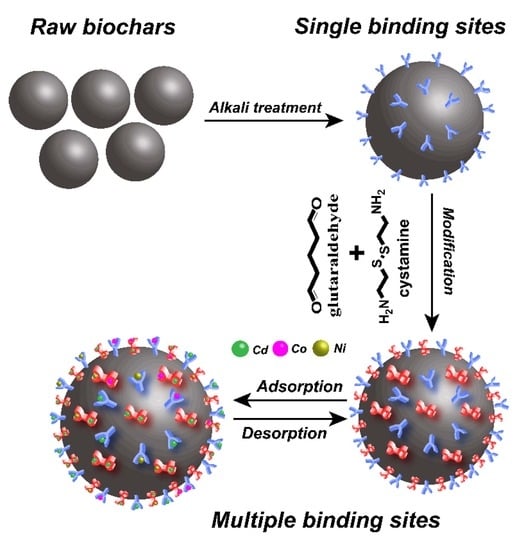Surface-Modified Biochar with Polydentate Binding Sites for the Removal of Cadmium
Abstract
:1. Introduction
2. Results and Discussion
2.1. Characterization of Raw and Modified Biochars
2.1.1. FTIR of Raw and Cystamine-Modified Biochars
2.1.2. TGA of Cystamine-Modified Biochars
2.1.3. X-ray Photoelectron Spectroscopy (XPS) and Elemental Analysis of Raw and Cystamine-Modified Biochars
2.1.4. SEM Image of Raw and Cystamine-Modified Biochars
2.2. Effects of pH and Ionic Strength
2.3. Adsorption Isotherms of Cd (II)
2.4. Adsorption Isotherms Fitting Model of Cd (II)
2.5. Adsorption Selectivity
2.6. Adsorption Kinetics
2.7. Adsorption Kinetics Fitting Model of Cd (II)
2.8. Repeatability Test
2.9. Discussion
3. Materials and Methods
3.1. Materials
3.2. The Base Treatment and Cystamine Modification Process
3.3. Characterization
3.4. Optimization of Adsorption Conditions
3.4.1. Optimization of pH
3.4.2. Optimization of Ionic Strength
3.5. Equilibrium Binding Experiments
3.6. Adsorption Selectivity toward Different Heavy Metal Ions
3.7. Adsorption Kinetic Experiment
3.8. Repeatability Test
4. Conclusions
Supplementary Materials
Author Contributions
Funding
Conflicts of Interest
References
- Carvalho, F.P. Pesticides, environment, and food safety. Food Energy Secur. 2017, 6, 48–60. [Google Scholar] [CrossRef] [Green Version]
- Yang, X.; Li, Q.; Tang, Z.; Zhang, W.; Yu, G.; Shen, Q.; Zhao, F.J. Heavy metal concentrations and arsenic speciation in animal manure composts in China. Waste Manag. 2017, 64, 333–339. [Google Scholar] [CrossRef]
- Järup, L. Hazards of heavy metal contamination. Br. Med. Bull. 2003, 68, 167–182. [Google Scholar] [CrossRef] [PubMed] [Green Version]
- Lu, Y.; Song, S.; Wang, R.; Liu, Z.; Meng, J.; Sweetman, A.J.; Wang, T. Impacts of soil and water pollution on food safety and health risks in China. Environ. Int. 2015, 77, 5–15. [Google Scholar] [CrossRef] [Green Version]
- McMurray, C.T.; Tainer, J.A. Cancer, cadmium and genome integrity. Nat. Genet. 2003, 34, 239. [Google Scholar] [CrossRef] [PubMed]
- Liu, L.; Li, W.; Song, W.; Guo, M. Remediation techniques for heavy metal-contaminated soils: Principles and applicability. Sci. Total Environ. 2018, 633, 206–219. [Google Scholar] [CrossRef]
- Wang, H.; Gao, B.; Wang, S.; Fang, J.; Xue, Y.; Yang, K. Removal of Pb (II), Cu (II), and Cd (II) from aqueous solutions by biochar derived from KMnO4 treated hickory wood. Bioresour. Technol. 2015, 197, 356–362. [Google Scholar] [CrossRef] [PubMed]
- Jung, K.W.; Lee, S.Y.; Lee, Y.J. Facile one-pot hydrothermal synthesis of cubic spinel-type manganese ferrite/biochar composites for environmental remediation of heavy metals from aqueous solutions. Bioresour. Technol. 2018, 261, 1–9. [Google Scholar] [CrossRef] [PubMed]
- Gupta, P.; Diwan, B. Bacterial exopolysaccharide mediated heavy metal removal: A review on biosynthesis, mechanism and remediation strategies. Biotechnol. Rep. 2017, 13, 58–71. [Google Scholar] [CrossRef] [PubMed]
- Zhang, F.; Wang, X.; Yin, D.; Peng, B.; Tan, C.; Liu, Y.; Wu, S. Efficiency and mechanisms of Cd removal from aqueous solution by biochar derived from water hyacinth (Eichornia crassipes). J. Environ. Manag. 2015, 153, 68–73. [Google Scholar] [CrossRef]
- Zhu, N.; Yan, T.; Qiao, J.; Cao, H. Adsorption of arsenic, phosphorus and chromium by bismuth impregnated biochar: Adsorption mechanism and depleted adsorbent utilization. Chemosphere 2016, 164, 32–40. [Google Scholar] [CrossRef] [PubMed]
- Li, F.; Shen, K.; Long, X.; Wen, J.; Xie, X.; Zeng, X.; Zhong, R. Preparation and characterization of biochars from Eichornia crassipes for cadmium removal in aqueous solutions. PLoS ONE 2016, 11, e0148132. [Google Scholar] [CrossRef]
- Abdelhafez, A.A.; Li, J.; Abbas, M.H. Feasibility of biochar manufactured from organic wastes on the stabilization of heavy metals in a metal smelter contaminated soil. Chemosphere 2014, 117, 66–71. [Google Scholar] [CrossRef]
- Mohan, D.; Sarswat, A.; Ok, Y.S.; Pittman, C.U., Jr. Organic and inorganic contaminants removal from water with biochar, a renewable, low cost and sustainable adsorbent-a critical review. Bioresour. Technol. 2014, 160, 191–202. [Google Scholar] [CrossRef]
- Tan, X.; Liu, Y.; Zeng, G.; Wang, X.; Hu, X.; Gu, Y.; Yang, Z. Application of biochar for the removal of pollutants from aqueous solutions. Chemosphere 2015, 125, 70–85. [Google Scholar] [CrossRef] [PubMed]
- Yap, M.W.; Mubarak, N.M.; Sahu, J.N.; Abdullah, E.C. Microwave induced synthesis of magnetic biochar from agricultural biomass for removal of lead and cadmium from wastewater. J. Ind. Eng. Chem. 2017, 45, 287–295. [Google Scholar] [CrossRef]
- Kambo, H.S.; Dutta, A. A comparative review of biochar and hydrochar in terms of production, physico-chemical properties and applications. Renew. Sustain. Energy Rev. 2015, 45, 359–378. [Google Scholar] [CrossRef]
- Lu, K.; Yang, X.; Gielen, G.; Bolan, N.; Ok, Y.S.; Niazi, N.K.; Liu, D. Effect of bamboo and rice straw biochars on the mobility and redistribution of heavy metals (Cd, Cu, Pb and Zn) in contaminated soil. J. Environ. Manag. 2017, 186, 285–292. [Google Scholar] [CrossRef]
- Khan, M.A.; Khan, S.; Ding, X.; Khan, A.; Alam, M. The effects of biochar and rice husk on adsorption and desorption of cadmium on to soils with different water conditions (upland and saturated). Chemosphere 2018, 193, 1120–1126. [Google Scholar] [CrossRef] [PubMed]
- Liu, J.; Schulz, H.; Brandl, S.; Miehtke, H.; Huwe, B.; Glaser, B. Short-term effect of biochar and compost on soil fertility and water status of a Dystric Cambisol in NE Germany under field conditions. J. Plant Nut. Soil Sci. 2012, 175, 698–707. [Google Scholar] [CrossRef]
- Ahmad, M.; Rajapaksha, A.U.; Lim, J.E.; Zhang, M.; Bolan, N.; Mohan, D.; Vithanage, M.; Lee, S.S.; Ok, Y.S. Biochar as a sorbent for contaminant management in soil and water: A review. Chemosphere 2014, 99, 19–33. [Google Scholar] [CrossRef] [PubMed]
- Ali, S.; Rizwan, M.; Qayyum, M.F.; Ok, Y.S.; Ibrahim, M.; Riaz, M.; Arif, M.S.; Hafeez, F.; Al-Wabel, M.I.; Shahzad, A.N. Biochar soil amendment on alleviation of drought and salt stress in plants: A critical review. Environ. Sci. Pollut. Res. Int. 2017, 24, 12700–12712. [Google Scholar] [CrossRef]
- Beesley, L.; Marmiroli, M. The immobilisation and retention of soluble arsenic, cadmium and zinc by biochar. Environ. Pollut. 2011, 159, 474–480. [Google Scholar] [CrossRef] [PubMed]
- Beesley, L.; Moreno-Jiménez, E.; Gomez-Eyles, J.L.; Harris, E.; Robinson, B.; Sizmur, T. A review of biochars’ potential role in the remediation, revegetation and restoration of contaminated soils. Environ. Pollut. 2011, 159, 3269–3282. [Google Scholar] [CrossRef] [PubMed]
- O’Connor, D.; Peng, T.; Zhang, J.; Tsang, D.C.W.; Alessi, D.S.; Shen, Z.; Bolan, N.S.; Hou, D. Biochar application for the remediation of heavy metal polluted land: A review of in situ field trials. Sci. Total Environ. 2018, 619, 815–826. [Google Scholar] [CrossRef] [PubMed]
- Abbas, T.; Rizwan, M.; Ali, S.; Zia-Ur-Rehman, M.; Farooq Qayyum, M.; Abbas, F.; Hannan, F.; Rinklebe, J.; Sik Ok, Y. Effect of biochar on cadmium bioavailability and uptake in wheat (Triticum aestivum L.) grown in a soil with aged contamination. Ecotoxicol. Environ. Saf. 2017, 140, 37–47. [Google Scholar] [CrossRef]
- Li, Z.; Delvaux, B.; Yans, J.; Dufour, N.; Houben, D.; Cornelis, J.T. Phytolith-rich biochar increases cotton biomass and silicon-mineralomass in a highly weathered soil. J. Plant Nutr. Soil Sci. 2018, 181, 537–546. [Google Scholar] [CrossRef]
- Li, Z.; Unzué-Belmonte, D.; Cornelis, J.T.; Linden, C.V.; Struyf, E.; Ronsse, F.; Delvaux, B. Effects of phytolithic rice-straw biochar, soil buffering capacity and pH on silicon bioavailability. Plant Soil 2019, 1–17. [Google Scholar] [CrossRef]
- Yang, X.; Lu, K.; McGrouther, K.; Che, L.; Hu, G.; Wang, Q.; Liu, X.; Shen, L.; Huang, H.; Ye, Z. Bioavailability of Cd and Zn in soils treated with biochars derived from tobacco stalk and dead pigs. J. Soils Sediment. 2017, 17, 751–762. [Google Scholar] [CrossRef]
- Ali, S.; Rizwan, M.; Noureen, S.; Anwar, S.; Ali, B.; Naveed, M.; Abd Allah, E.F.; Alqarawi, A.A.; Ahmad, P. Combined use of biochar and zinc oxide nanoparticle foliar spray improved the plant growth and decreased the cadmium accumulation in rice (Oryza sativa L.) plant. Environ. Sci. Pollut. Res. Int. 2019, 1–12. [Google Scholar] [CrossRef]
- Houben, D.; Evrard, L.; Sonnet, P. Mobility, bioavailability and pH-dependent leaching of cadmium, zinc and lead in a contaminated soil amended with biochar. Chemosphere 2013, 1450–1457. [Google Scholar] [CrossRef] [PubMed]
- Inyang, M.I.; Gao, B.; Yao, Y.; Xue, Y.; Zimmerman, A.; Mosa, A.; Pullammanappallil, P.; Ok, Y.S.; Cao, X. A review of biochar as a low-cost adsorbent for aqueous heavy metal removal. Crit. Rev. Environ. Sci. Technol. 2016, 46, 406–433. [Google Scholar] [CrossRef]
- Rizwan, M.; Ali, S.; Abbas, T.; Adrees, M.; Zia-ur-Rehman, M.; Ibrahim, M.; Abbas, F.; Qayyum, M.F.; Nawaz, R. Residual effects of biochar on growth, photosynthesis and cadmium uptake in rice (Oryza sativa L.) under Cd stress with different water conditions. J. Environ. Manag. 2018, 206, 676–683. [Google Scholar] [CrossRef]
- Yang, X.; Liu, J.; McGrouther, K.; Huang, H.; Lu, K.; Guo, X.; He, L.; Lin, X.; Che, L.; Ye, Z.; et al. Effect of biochar on the extractability of heavy metals (Cd, Cu, Pb, and Zn) and enzyme activity in soil. Environ. Sci. Pollut. Res. Int. 2016, 23, 974–984. [Google Scholar] [CrossRef]
- Zhang, X.; Wang, H.; He, L.; Lu, K.; Sarmah, A.; Li, J.; Bolan, N.S.; Pei, J.; Huang, H. Using biochar for remediation of soils contaminated with heavy metals and organic pollutants. Environ. Sci. Pollut. Res. 2013, 20, 8472–8483. [Google Scholar] [CrossRef]
- Park, J.H.; Ok, Y.S.; Kim, S.H.; Cho, J.S.; Heo, J.S.; Delaune, R.D.; Seo, D.C. Competitive adsorption of heavy metals onto sesame straw biochar in aqueous solutions. Chemosphere 2016, 142, 77–83. [Google Scholar] [CrossRef]
- Alam, M.S.; Swaren, L.; von Gunten, K.; Cossio, M.; Bishop, B.; Robbins, L.J.; Alessi, D.S. Application of surface complexation modeling to trace metals uptake by biochar-amended agricultural soils. Appl. Geochem. 2018, 88, 103–112. [Google Scholar] [CrossRef]
- Rajapaksha, A.U.; Chen, S.S.; Tsang, D.C.; Zhang, M.; Vithanage, M.; Mandal, S.; Ok, Y.S. Engineered/designer biochar for contaminant removal/immobilization from soil and water: Potential and implication of biochar modification. Chemosphere 2016, 148, 276–291. [Google Scholar] [CrossRef]
- Li, H.; Dong, X.; da Silva, E.B.; de Oliveira, L.M.; Chen, Y.; Ma, L.Q. Mechanisms of metal sorption by biochars: Biochar characteristics and modifications. Chemosphere 2017, 178, 466–478. [Google Scholar] [CrossRef]
- Ma, Y.; Liu, W.J.; Zhang, N.; Li, Y.S.; Jiang, H.; Sheng, G.P. Polyethylenimine modified biochar adsorbent for hexavalent chromium removal from the aqueous solution. Bioresour. Technol. 2014, 169, 403–408. [Google Scholar] [CrossRef] [PubMed]
- Ding, Z.; Hu, X.; Wan, Y.; Wang, S.; Gao, B. Removal of lead, copper, cadmium, zinc, and nickel from aqueous solutions by alkali-modified biochar: Batch and column tests. J. Ind. Eng. Chem. 2016, 33, 239–245. [Google Scholar] [CrossRef] [Green Version]
- Liang, J.; Li, X.; Yu, Z.; Zeng, G.; Luo, Y.; Jiang, L.; Wu, H. Amorphous MnO2 modified biochar derived from aerobically composted swine manure for adsorption of Pb (II) and Cd (II). ACS Sustain. Chem. Eng. 2017, 5, 5049–5058. [Google Scholar] [CrossRef]
- Peng, H.; Gao, P.; Chu, G.; Pan, B.; Peng, J.; Xing, B. Enhanced adsorption of Cu (II) and Cd (II) by phosphoric acid-modified biochars. Environ. Pollut. 2017, 229, 846–853. [Google Scholar] [CrossRef]
- Zhao, T.; Wang, J.; He, J.; Deng, Q.; Wang, S. One-step post-imprint modification achieve dual-function of glycoprotein fluorescent sensor by “Click Chemistry”. Biosens. Bioelectron. 2017, 91, 756–761. [Google Scholar] [CrossRef]
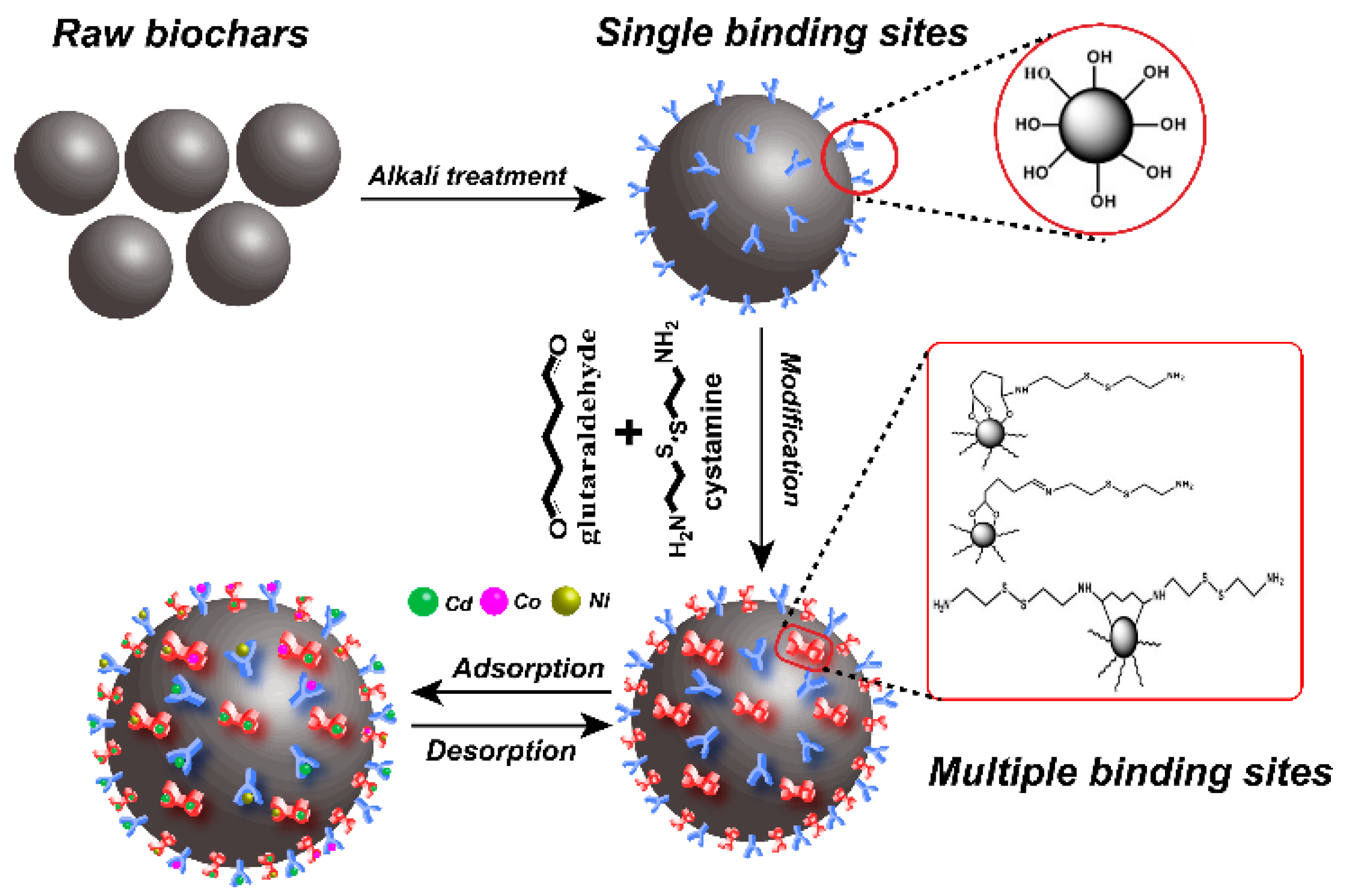
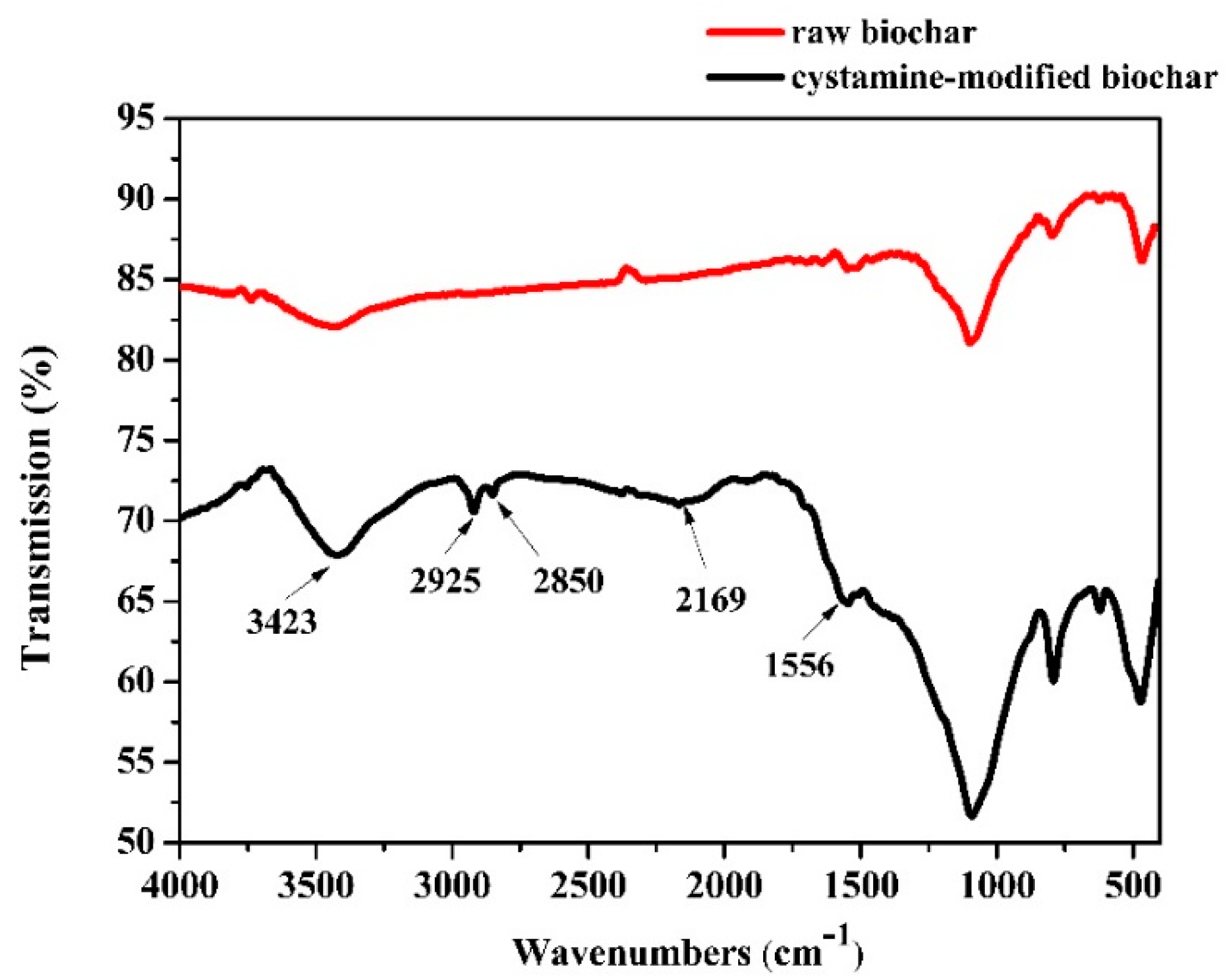

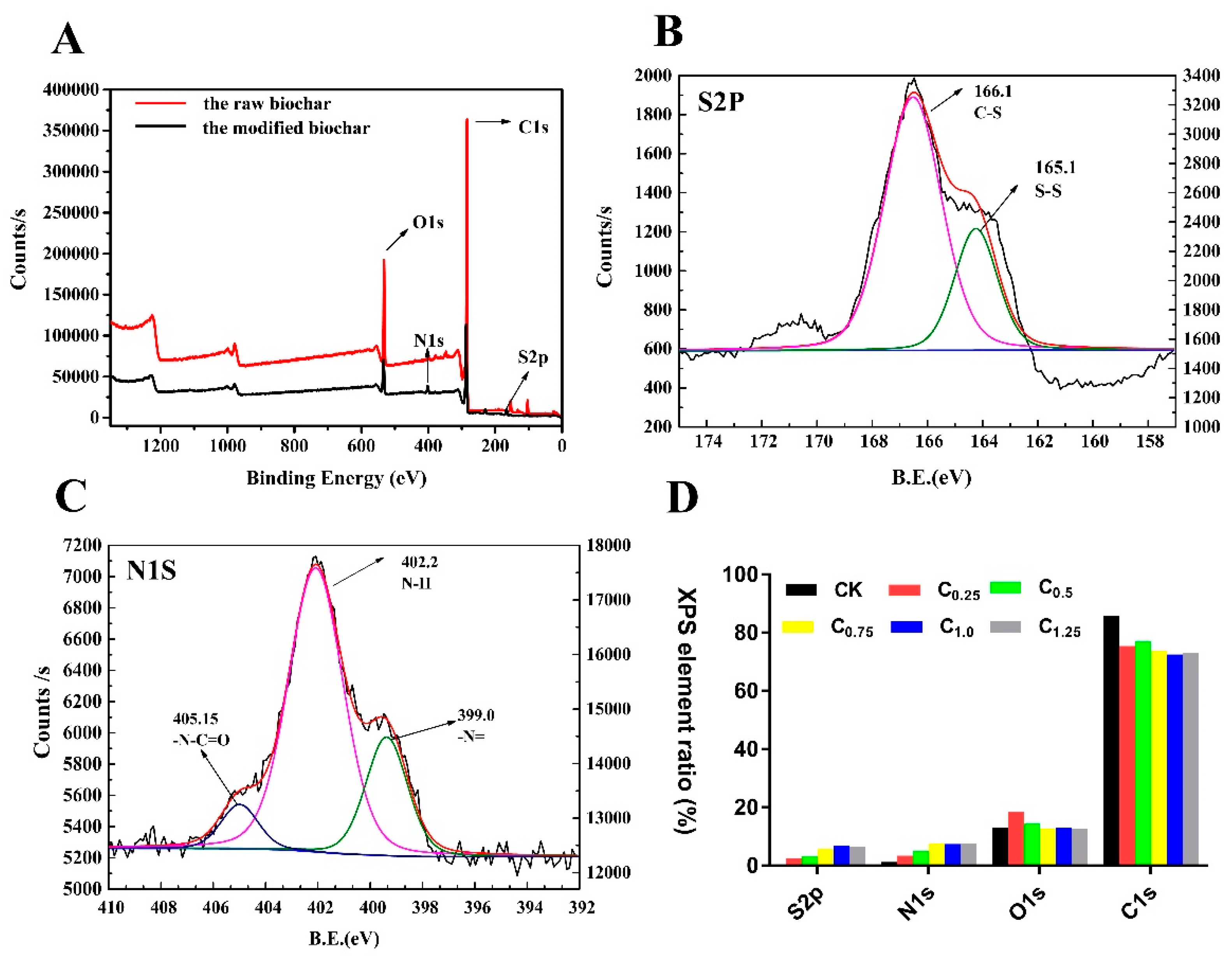
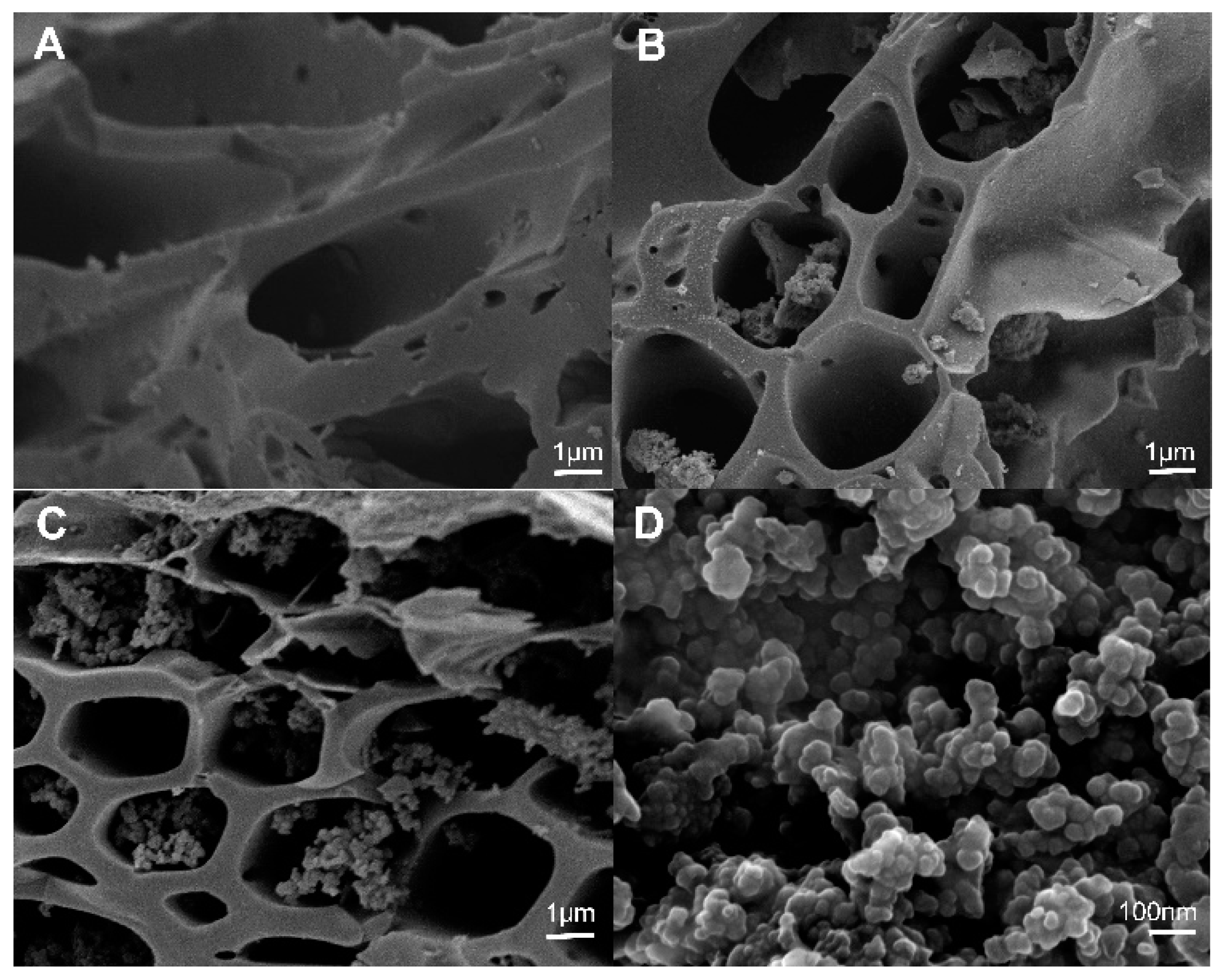
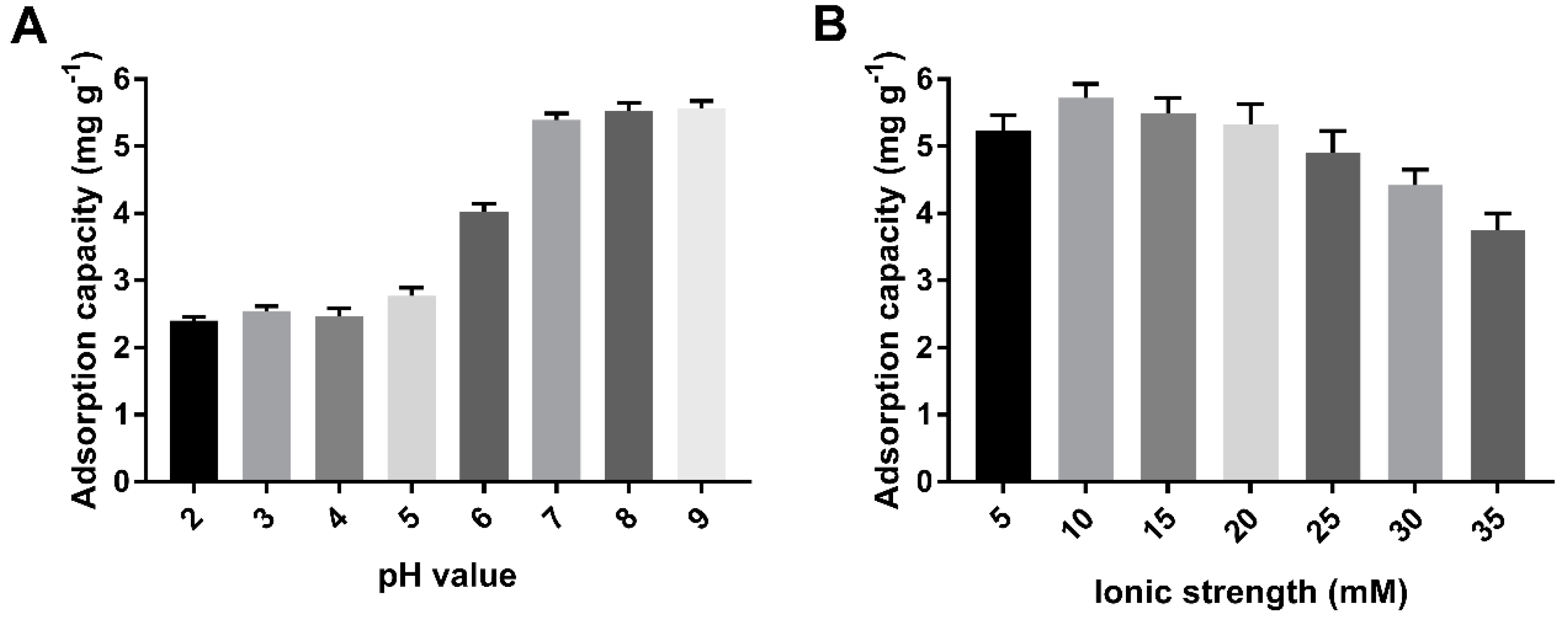
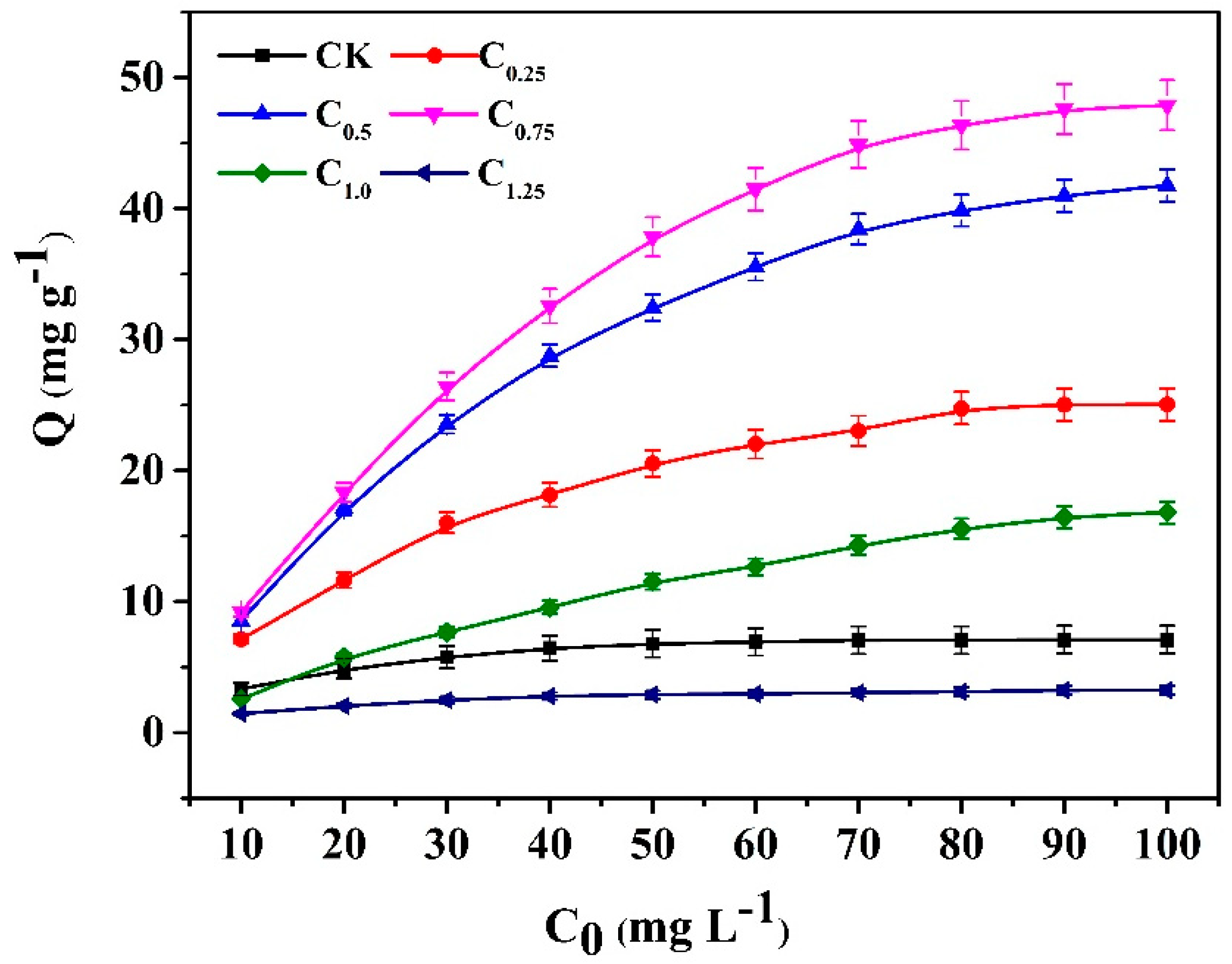
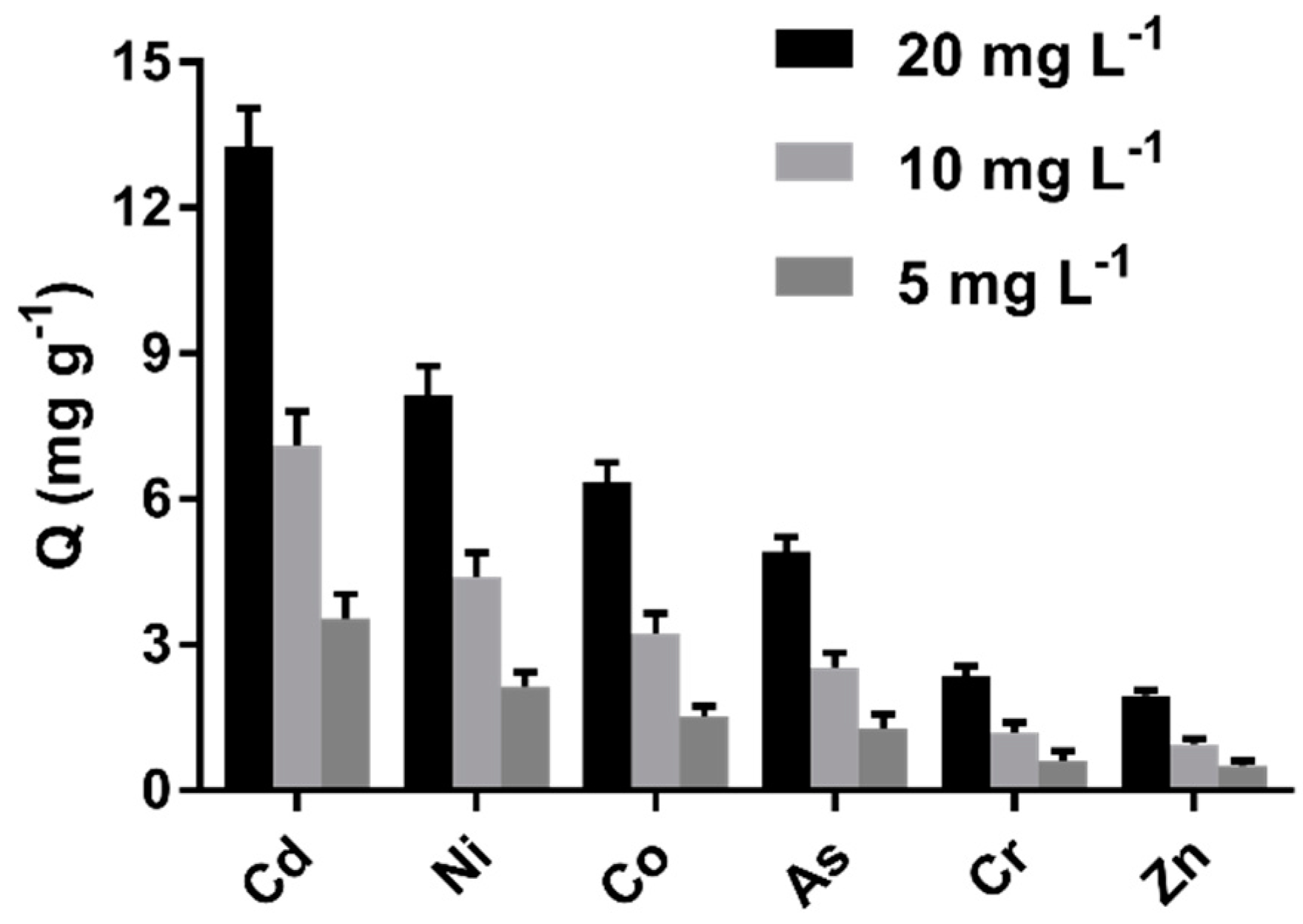


| Samples | Quality (mg) | N Area | C Area | H Area | S Area | N (%) | C (%) | H (%) | S (%) | C/N | C/H |
|---|---|---|---|---|---|---|---|---|---|---|---|
| CK | 2.1064 | 390 | 25,811 | 1662 | 138 | 0.43 | 38.94 | 0.840 | 0.466 | 90.95 | 46.42 |
| C0.25 | 2.0917 | 1071 | 41,020 | 3071 | 445 | 1.18 | 52.47 | 1.513 | 1.497 | 52.73 | 41.28 |
| C0.50 | 2.1287 | 1424 | 38,837 | 3527 | 833 | 1.55 | 58.09 | 1.696 | 2.725 | 37.58 | 34.25 |
| C0.75 | 2.0577 | 1597 | 37,403 | 3494 | 913 | 1.79 | 57.84 | 1.739 | 3.090 | 32.28 | 32.93 |
| C1.00 | 2.0803 | 2047 | 35,253 | 4516 | 1271 | 2.27 | 53.93 | 2.193 | 4.262 | 23.78 | 24.62 |
| C1.25 | 2.1690 | 2028 | 36,839 | 4779 | 1234 | 2.21 | 54.20 | 2.219 | 3.962 | 24.52 | 24.42 |
| Samples | Surface Area (m2/g) | Pore Volume (cm3/g) | Pore Width (nm) |
|---|---|---|---|
| CK | 46.196 | 0.071 | 7.838 |
| C0.25 | 41.412 | 0.047 | 5.300 |
| C0.50 | 23.743 | 0.043 | 3.794 |
| C0.75 | 19.065 | 0.041 | 3.390 |
| C1.00 | 18.181 | 0.039 | 3.394 |
| C1.25 | 16.271 | 0.034 | 1.272 |
| Model | Parms | Samples | |||||
|---|---|---|---|---|---|---|---|
| CK | C0.25 | C0.50 | C0.75 | C1.00 | C1.25 | ||
| Langmuir | q0 | 8.347 ± 0.179 | 35.82 ± 0.95 | 67.843 ± 3.82 | 81.02 ± 5.35 | 36.18 ± 2.01 | 3.765 ± 0.045 |
| Kt | 0.072 ± 0.07 | 0.026 ± 0.002 | 0.018 ± 0.002 | 0.016 ± 0.002 | 0.009 ± 0.008 | 0.063 ± 0.003 | |
| R2 | 0.980 | 0.995 | 0.990 | 0.987 | 0.997 | 0.995 | |
| Freundlich | KF | 2.174 ± 0.348 | 3.031 ± 0.498 | 3.365 ± 0.762 | 3.664 ± 0.868 | 0.735 ± 0.113 | 0.851 ± 0.104 |
| n | 3.667 ± 0.532 | 2.111 ± 0.175 | 1.778 ± 0.170 | 1.735 ± 0.169 | 1.447 ± 0.076 | 3.339 ± 0.333 | |
| R2 | 0.886 | 0.964 | 0.957 | 0.956 | 0.987 | 0.943 | |
| Model | Param | Samples | |||||
|---|---|---|---|---|---|---|---|
| CK | C0.25 | C0.5 | C0.75 | C1.0 | C1.25 | ||
| PFO | qe | 7.6 ± 0.07 | 35.08 ± 0.59 | 60.3 ± 1.0 | 75.28 ± 1.16 | 25.1 ± 0.6 | 2.863 ± 0.072 |
| k1 | 0.021 ± 0.001 | 0.008 ± 0.001 | 0.007 ± 0.001 | 0.007 | 0.009 ± 0.001 | 0.006 ± 0.001 | |
| R2 | 0.986 | 0.985 | 0.987 | 0.978 | 0.964 | 0.976 | |
| PSO | qe | 7.858 ± 0.002 | 39.03 ± 0.01 | 68.31 ± 0.13 | 85.41 ± 0.43 | 27.73 ± 0.36 | 3.31 ± 0.05 |
| k2 | 0.006 | 0.0003 | 0.0001 | 0.0001 | 0.0004 | 0.0021 | |
| R2 | 0.976 | 0.993 | 0.994 | 0.995 | 0.994 | 0.996 | |
| Method | Biochar | Ce (mg L−1) | qe (mg g−1) | Enrichment Factor |
|---|---|---|---|---|
| [7] KMnO4 | Hickory wood | 125 | 28.1 | 5.9 |
| [10] Heating | Water hyacinth | 200 | 70.3 | - |
| [41] Alkali | Hickory wood | 100 | 0.98 | 4.9 |
| [42] MnO2 | Swine manure | 125 | 45.8 | 3.2 |
| [43] H3PO4 | Pine sawdust | 5 | 20 | 4 |
| Cystamine | Rice husk | 80 | 47.9 | 7 |
© 2019 by the authors. Licensee MDPI, Basel, Switzerland. This article is an open access article distributed under the terms and conditions of the Creative Commons Attribution (CC BY) license (http://creativecommons.org/licenses/by/4.0/).
Share and Cite
Chen, R.; Zhao, X.; Jiao, J.; Li, Y.; Wei, M. Surface-Modified Biochar with Polydentate Binding Sites for the Removal of Cadmium. Int. J. Mol. Sci. 2019, 20, 1775. https://doi.org/10.3390/ijms20071775
Chen R, Zhao X, Jiao J, Li Y, Wei M. Surface-Modified Biochar with Polydentate Binding Sites for the Removal of Cadmium. International Journal of Molecular Sciences. 2019; 20(7):1775. https://doi.org/10.3390/ijms20071775
Chicago/Turabian StyleChen, Rongqi, Xi Zhao, Juan Jiao, Yan Li, and Min Wei. 2019. "Surface-Modified Biochar with Polydentate Binding Sites for the Removal of Cadmium" International Journal of Molecular Sciences 20, no. 7: 1775. https://doi.org/10.3390/ijms20071775
APA StyleChen, R., Zhao, X., Jiao, J., Li, Y., & Wei, M. (2019). Surface-Modified Biochar with Polydentate Binding Sites for the Removal of Cadmium. International Journal of Molecular Sciences, 20(7), 1775. https://doi.org/10.3390/ijms20071775



